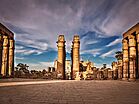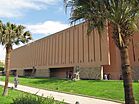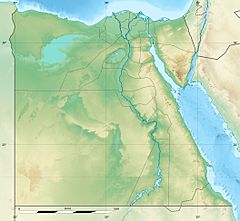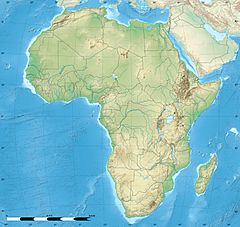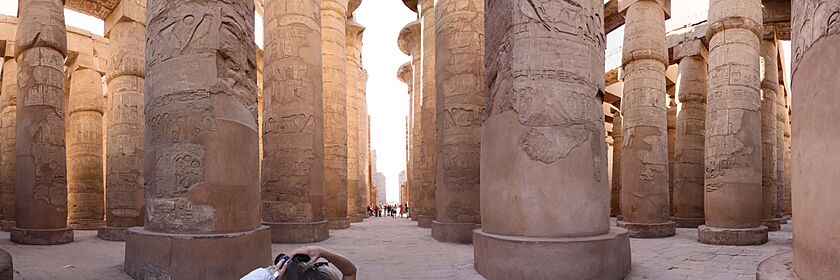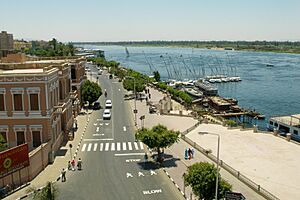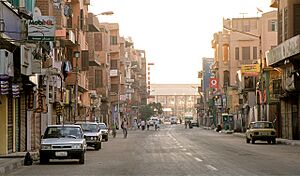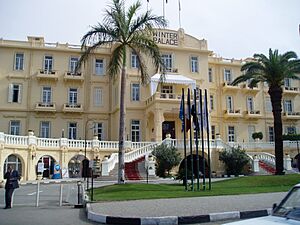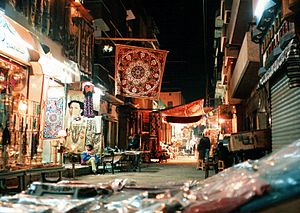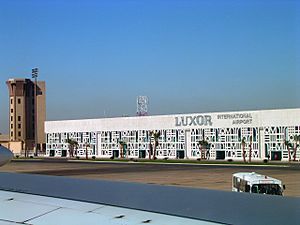Luxor facts for kids
Quick facts for kids
Luxor
الأقصر
ⲡⲁⲡⲉ ⲡϣⲟⲙⲧ ⲛ̀ⲕⲁⲥⲧⲣⲟⲛ
|
||
|---|---|---|
|
From top, left to right:
Buildings on the Nile banks, statue of Ramses II, Luxor Maritim Jolie Ville, Luxor Temple, Luxor Museum, Aerial view of Luxor, Luxor Corniche |
||
|
||
| Nickname(s):
City of Palaces
|
||
| Country | ||
| Governorate | Luxor | |
| Area | ||
| • Total | 417 km2 (161 sq mi) | |
| Elevation | 89 m (292 ft) | |
| Population
(2020)
|
||
| • Total | 1,333,309 | |
| • Density | 3,197/km2 (8,281/sq mi) | |
| • Demonym | Luxorian | |
| GDP | ||
| • Total | EGP 47 billion (US$ 3 billion) |
|
| Time zone | UTC+02:00 (EET) | |
| Area code(s) | (+20) 95 | |
Luxor is a famous city in Upper Egypt. It sits where the ancient Egyptian city of Thebes once stood. In 2020, Luxor had over 1.3 million people. It covers about 417 square kilometers. Luxor is the capital of the Luxor Governorate. It is one of the oldest cities in the world where people have lived continuously.
Many people call Luxor the "world's greatest open-air museum." This is because the amazing ruins of Egyptian temples like Karnak and Luxor are right inside the modern city. Across the River Nile, you can find more ancient sites. These include the Theban Necropolis, the Valley of the Kings, and the Valley of the Queens. Thousands of visitors come to Luxor every year. They explore these ancient wonders, which helps the city's economy.
Contents
What's in a Name?
The name Luxor comes from an Arabic word, qasr. This word means "castle" or "palace." In its plural form, al-quṣūr, it means "the palaces." This might be why the ancient Greeks and Copts called the area "three castles."
The old Coptic name for the city was Pape. This name came from an ancient Egyptian word meaning "the shrine" or "the temple." The Greeks later called the city Thebes or Diospolis. The ancient Egyptians called it Waset, meaning "city of the sceptre." It was also known as "the city of the 100 gates." Sometimes, it was called "southern Heliopolis" to tell it apart from another city called Heliopolis in the north.
A Glimpse into Luxor's Past

Luxor was once the mighty city of Thebes. It was the capital of Upper Egypt during the New Kingdom. Thebes was also the main city for the god Amun, who later became Amun-Ra. Ancient Egyptians called it Waset, meaning "city of the sceptre." Later, they called it ta jpt, meaning "the shrine/temple." This referred to the great Karnak temple.
The city became very important around the 11th Dynasty. Montuhotep II united Egypt, bringing peace and helping Thebes grow. During the New Kingdom, pharaohs went on expeditions to places like Sudan and Syria. This brought great wealth to Thebes, making it a powerful city in the ancient world. Thebes played a key role in driving out the Hyksos invaders. From the 18th Dynasty to the 20th Dynasty, it was Egypt's political, religious, and military capital.
People from many lands visited Thebes. These included the Babylonians, Hittites, and Minoans. Even a Hittite prince came to marry Tutankhamun's widow. Later, Thebes lost its political power to northern cities like Alexandria.
However, Thebes remained Egypt's religious center. This was because it was the city of the god Amun-Ra. Amun was worshipped with his wife, Mut, and their son, Khonsu. As Thebes grew, Amun became linked with the sun god Ra. This created Amun-Ra, the "king of gods." His huge temple at Karnak was the most important temple in Egypt for a very long time.
Later, the Assyrian emperor Ashurbanipal attacked the city. Thebes was left in ruins and lost much of its importance. Still, Alexander the Great visited the temple of Amun. Thebes remained a spiritual place even into Christian times. Many Christian monks built monasteries there, like the one at Hatshepsut's temple, now called Deir el-Bahri.
After the Muslim conquest of Egypt, part of the Luxor Temple became a mosque. Today, it is known as the Abu Haggag Mosque. In the 18th century, more Europeans started visiting Luxor. They wrote about their travels and documented the ancient sites. By the 20th century, Luxor had become a major tourist spot.
Amazing Discoveries

Archaeologists are always finding new things in Luxor. In April 2018, a shrine to the god Osiris-Ptah Neb was found at the Temple of Karnak. It dated back to the 25th dynasty. They found clay pots and parts of statues there.
In November 2018, two more discoveries were announced. One was a 13th-century tomb belonging to Thaw-Irkhet-If. He was in charge of mummification at the temple of Mut. The tomb had colorful scenes and 1,000 small statues called ushabti. Another discovery was 1,000 ushabti and two coffins with mummies inside. One coffin was opened for the media. It held the mummy of a woman named Thuya from the 18th Dynasty.
In October 2019, archaeologists led by Zahi Hawass found an ancient "industrial area." This area was used to make decorations, furniture, and pottery for royal tombs. It had a large kiln for ceramics and 30 workshops. Each workshop made different things, like pottery, gold items, or furniture. They also found beads, silver rings, and gold foil that once decorated wooden coffins.
Also in October 2019, thirty well-preserved wooden coffins were found. They were 3,000 years old and found near the Mortuary Temple of Hatshepsut. The coffins held mummies of 23 adult males, 5 adult females, and 2 children. These people were likely from the middle class. The coffins had carvings of Egyptian gods, hieroglyphs, and scenes from the Book of the Dead.
On April 8, 2021, archaeologists found Aten, a 3,400-year-old "lost golden city." It is near Luxor and is the largest ancient Egyptian city ever found. Experts say it's the second most important discovery since Tutankhamen's tomb. This site shows us what daily life was like for ancient Egyptians. They found pottery, rings, and tools.
Famous Landmarks
West Bank Wonders
|
East Bank Treasures
|
Luxor's Climate
Luxor has a very hot desert climate. It is one of the sunniest and driest cities in the world. Average high temperatures are often above 40°C (104°F) in summer. Even in the coolest month, high temperatures stay above 22°C (71.6°F).
Luxor gets very little rain, less than 1 millimeter per year on average. Sometimes, it doesn't rain at all for an entire year. The air is very dry. Luxor is clear, bright, and sunny almost all year. It gets about 4,000 hours of sunshine each year.
The temperature difference between day and night in Luxor can be large. It can be almost 16°C (29°F) different. The hottest temperature ever recorded was 50°C (122°F) in May 1991. The coldest was -1°C (30°F) in February 1989.
| Climate data for Luxor (1991–2020) | |||||||||||||
|---|---|---|---|---|---|---|---|---|---|---|---|---|---|
| Month | Jan | Feb | Mar | Apr | May | Jun | Jul | Aug | Sep | Oct | Nov | Dec | Year |
| Record high °C (°F) | 32.9 (91.2) |
38.5 (101.3) |
42.2 (108.0) |
46.2 (115.2) |
50.0 (122.0) |
48.5 (119.3) |
47.8 (118.0) |
47.0 (116.6) |
46.0 (114.8) |
43.0 (109.4) |
38.2 (100.8) |
34.8 (94.6) |
50.0 (122.0) |
| Mean daily maximum °C (°F) | 22.8 (73.0) |
25.3 (77.5) |
29.7 (85.5) |
35.0 (95.0) |
39.1 (102.4) |
41.2 (106.2) |
41.4 (106.5) |
41.2 (106.2) |
39.3 (102.7) |
35.5 (95.9) |
29.1 (84.4) |
24.2 (75.6) |
33.6 (92.5) |
| Daily mean °C (°F) | 14.7 (58.5) |
17.1 (62.8) |
21.3 (70.3) |
27.5 (81.5) |
31.0 (87.8) |
33.3 (91.9) |
33.9 (93.0) |
33.6 (92.5) |
31.3 (88.3) |
27.4 (81.3) |
21.0 (69.8) |
16.1 (61.0) |
25.6 (78.1) |
| Mean daily minimum °C (°F) | 7.1 (44.8) |
8.9 (48.0) |
12.8 (55.0) |
17.5 (63.5) |
22.1 (71.8) |
25.0 (77.0) |
25.7 (78.3) |
25.6 (78.1) |
23.3 (73.9) |
19.6 (67.3) |
13.4 (56.1) |
8.6 (47.5) |
17.4 (63.3) |
| Record low °C (°F) | −0.3 (31.5) |
−1.0 (30.2) |
0.0 (32.0) |
6.5 (43.7) |
12.5 (54.5) |
16.0 (60.8) |
19.2 (66.6) |
19.2 (66.6) |
15.8 (60.4) |
9.8 (49.6) |
3.7 (38.7) |
0.7 (33.3) |
−1.0 (30.2) |
| Average precipitation mm (inches) | 2.8 (0.11) |
0.4 (0.02) |
1.7 (0.07) |
0.3 (0.01) |
0.8 (0.03) |
0.0 (0.0) |
0.0 (0.0) |
0.1 (0.00) |
0.5 (0.02) |
1.1 (0.04) |
0.5 (0.02) |
0.0 (0.0) |
8.3 (0.33) |
| Average precipitation days (≥ 1 mm) | 0.3 | 0.4 | 0.3 | 0.1 | 0.3 | 0.0 | 0.0 | 0.0 | 0.1 | 0.3 | 0.1 | 1.0 | 1.9 |
| Average relative humidity (%) | 55 | 47 | 39 | 31 | 29 | 27 | 30 | 33 | 37 | 43 | 51 | 57 | 39.9 |
| Source: NOAA (humidity 1961–1990) | |||||||||||||
Luxor's Economy
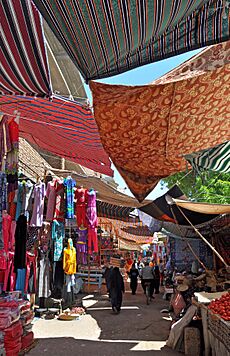
Luxor's economy mostly relies on tourism. Since 1988, Luxor has been the only city in Egypt to offer hot air balloon rides. This is a very popular activity for tourists. Many people also work in farming, especially growing sugarcane. There are also local industries, like making pottery.
Tourism in Luxor has faced challenges over the years. After certain events, the number of tourists dropped for a while. For example, in 2013, a hot air balloon crash caused a temporary decline in visitors. To help make up for lost income, many residents grow their own food. Things like goat's cheese, pigeons, and homegrown tomatoes are common.
Tourism Development Plans
There are plans to make Luxor an even bigger open-air museum. This includes building new roads, hotels, and shops. A major project is uncovering and restoring the 2.7-kilometer (1.7-mile) long Avenue of Sphinxes. This ancient road once connected the Luxor and Karnak temples. Pharaoh Amenhotep III built it, and it was finished by Nectanebo I around 400 BCE. Over a thousand sphinx statues lined this road. Excavation work began around 2004.
Archaeologists continue to make exciting finds. In April 2019, a previously unopened coffin was found in Luxor. It dated back to the 18th dynasty. Experts said it was the biggest rock-cut tomb found in ancient Thebes. It is one of the largest and best-preserved tombs found near Luxor.
Getting Around Luxor
Luxor has its own airport, Luxor International Airport. A bridge was built in 1998, a few kilometers from the city. This bridge makes it easy to travel between the east and west banks of the Nile. Before the bridge, people used ferry services to cross the river. The "local ferry" still runs from a spot near Luxor Temple.
On the west bank, you can get around by taxi. There are also local cars that go to some monuments for a small fee. Motorboats offer quicker crossings across the Nile, but they cost more.
In the city of Luxor on the east bank, there are bus routes for locals. Tourists often use horse carriages, called "calèches," for tours. Taxis are also common and affordable. Many modern, air-conditioned taxis are now available. New roads have been built to handle more traffic.
For longer trips, a train service runs several times a day. You can take a morning train or a sleeping train from Luxor railway station. This train line connects Luxor to major cities like Cairo in the north and Aswan in the south.
Luxor University
Luxor University was started in 2019. It is a non-profit government university. It offers many different programs and courses for students.
Sister Cities
Luxor has special connections with other cities around the world. These are called "sister cities":
Images for kids
See also
 In Spanish: Luxor para niños
In Spanish: Luxor para niños





